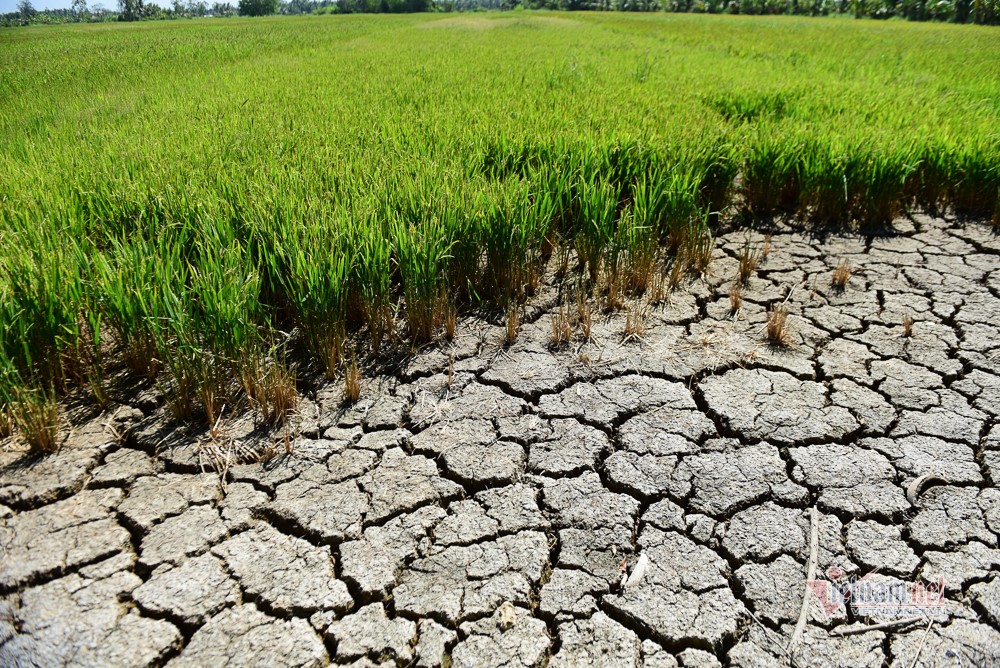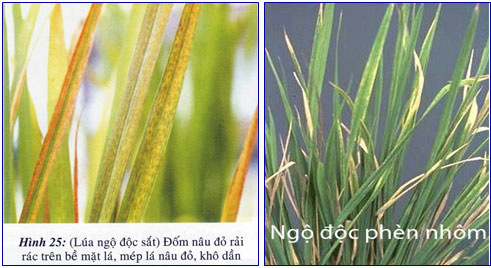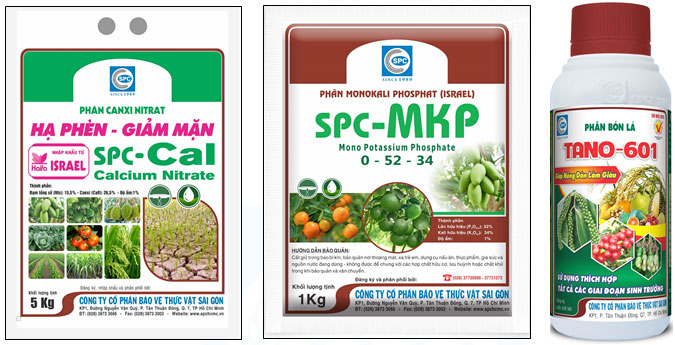|
Application Of Spc-Cal Fertilizer Salinity Contaminated, Acid Leaking Soil
31/08/2021
BSc Do Cong Hoang I. CURRENT SITUATION OF SALINITY CONTAMINATED ,ACID LEAKING SOIL: According to experts, this year is western salinity is very severe and even more severe than the historical one in 2016. Across the current Mekong Delta, the condition of the land is cracked and the rice withered. However, the most heavily affected by saltwater intrusion are riverine and coastal areas. As a rule, every previous year the flood is low, the next year there is a severe drought. In 2019, the flood was low, so in 2020 a large-scale drought and salinity was warned in advance. In the Mekong Delta, in addition to the drought and salinity of the soil, it is also having to deal with the acid leaking soil in situation, because the Mekong Delta is mostly iron acid soil, with drought and saline intrusion as long as this year there will be In many areas of rice cultivation, when water is brought in to sow Summer-Autumn rice, it will lead to rice poisoning with acid sulphate to be unavoidable. For the upland field areas, when experiencing severe drought and cracked soil (with acid ), in addition to iron acid (hot acid), aluminum acid (cold acid) often appears. Aluminum acid has an easy-to-observe appearance as a white layer like (aluminum sulphate), they block the absorption of water by rice, so the leaves are dry, curled at the edges, the roots are curled, deformed and easily broken. If acid poisoning lasts for a long time, the leaves will turn yellow, the rice plants will be stunted and died * Cause of acid leakage: Due to prolonged drought from the Winter-Spring crop, accompanied by little rainfall and uneven distribution at the beginning of the Summer-Autumn crop, if not proactively supplemented with irrigation water to suppress acid, will make the soil layers containing acid-producing materials easily oxidized, leading to the phenomenon of acid leakage through cracks and capillaries in the soil. At this time, the soil has a very acidic pH, and the mobile Fe2+ and Al3+ concentrations in the soil solution are also very high, which is the main cause of the poisoning of rice roots and rice plants. Saltwater intrusion and acid leakage not only affect the Winter-Spring rice crop but also threaten hundreds of thousands of hectares of Spring-Summer-Autumn rice about to sow. Currently, the agricultural sector of the Mekong Delta provinces is closely following the fields, closely monitoring the evolution of saltwater intrusion, regularly checking the salinity in the sluices, canals and creeks to promptly guide people to handle salinity to save rice, take the initiative to pump water to irrigate fields. In the coming time, it is necessary to restructure the crop to avoid drought and salinity; In areas often affected by salinity, put rice varieties tolerant to acid, salinity, short-term varieties, etc. into production to reduce damage caused by drought and salinity. II. HOW TO 0VERCOME: 1. Before making the soil to sow the Summer-Autumn crop: According to research by the Southern Institute of Irrigation Planning, fresh water plays the most important role in removing acid and washing saltwater. Farmers can take advantage of high water waves to pour water into the fields to discharge acid and salt into the canals; With soil contaminated with acid, it is not advisable to let the rice field dry out ,because the water layer on the field surface has the effect of suppressing acid.. Besides, farmers need to take advantage of heavy rains to discharge all the water in the field to continue to have a new place to store new rain water. After draining the water for 1 day, put the water back in, apply 5 kg of SPC-CAL fertilizer (Calcium Nitrate) for (1,000m2), soak the field for about 5 days, then drain the water to remove toxic elements for the plant. Rice fields such as: Iron (Fe), aluminum (Al) and Sodium (Na) help lower acid and reduce salinity in the soil. Change the water to the field as many times as possible for the growth of rice plants later. 2. Soil preparation and sowing for Summer-Autumn crop: - Soil preparation: Do not plow too deeply on acid contaminated fields. - Basal application: 5 kg of SPC-CAL fertilizer for 1,000 m2 of field before the last harrowing for sowing. - Top dressing: In addition to applying NPK fertilizers as usual, it is necessary to add 3 - 5 kg of SPC-CAL fertilizer for 1,000 m2 of field when the first additional application (10 - 12 days after sowing) and when pre-heading fertilization (40 - 45 days after sowing). After sowing, in the seedling stage, if the rice plants have acid poisoning, salt poisoning, farmers need to stop fertilizing urea, DAP or NPK immediately, because at this time the rice roots have been damaged, poor nutrient absorption in the soil . To overcome the situation of rice plants being poisoned by acid, salt and help rice recover the function of the roots, it is necessary to perform the following steps: • Step 1: Add clean water to the field to dilute the toxicity of Fe, Al or Na in the soil, and at the same time prevent the soil from oxidizing leading to acid leakage. If possible, remove the old water and replace it with new water, which will have a better effect of removing acid, washing salt, and changing the water as many times as possible. • Step 2: Apply 5 kg of SPC-CAL fertilizer/1,000 m2 to quickly raise the pH of the soil, neutralize organic acids, Fe2+, Al3+, Na+ etc helping the rice roots get rid of poisoning and stimulate cell growth get long. After applying SPC-CAL about 5 days, it is recommended to change the water to remove acid, salt and toxins remaining in the water. • Step 3: In order to help the roots recover quickly, as well as provide the necessary nutrients for rice plants to grow while the roots have not yet recovered, farmers need to promptly spray more SPC is high-grade foliar fertilizer in a timely manner as follows: - Spray foliar fertilizer SPC-MKP and TANO 601 twice 5-7 days apart with a dose of 120g of SPC-MKP fertilizer plus 60ml of TANO 601 for a 25-liter- water tank, spray 1.5 tanks for 1,000m2 in cool weather. . - After spraying foliar fertilizer 5-7 days, pull up the rice bunch to observe, if white roots appear, it means that the rice roots have recovered, the rice plants have overcome the status of acid poisoning or salt poisoning. . At this time, it is necessary to add DAP fertilizer or NPK compound fertilizer to fully provide essential nutrients according to the needs of rice plants. Three fertilizer products SPC-CAL, SPC-MKP and TANO 601 distributed by SPC company, in the past time have been used by many farmers, in addition to bringing practical effects in limiting To prevent damage when rice plants are poisoned by acid, salt poisoning in particular, the above fertilizers are also widely applied in agricultural production in general, helping to improve productivity and quality for many crops.
|
To prevent, in addition to plowing and burying weed seeds, collecting weed stalks and stumps left after tilling the land to burn, not letting weeds produce seeds in production fields, etc., the use of chemical products is still a measure. optimal because of its ability to thoroughly kill weeds, reduce labor and take advantage of more time than manual weeding.
Miner has the scientific name Phyllocnistis citrella Staint., family Phyllocnistidae, order Lepidoptera. The miner occurs in many countries in the tropics and subtropics. The main host of the miner is the citrus family - Rutaceae. In addition, the miner also attacks mangosteen and some other plants.
Adult is a small planthopper, with a body 2-3 mm long, the whole body is ash gray, slightly greenish, the wings are opaque with many small brown spots.Eggs are oval, 0.3 mm long, have a pointed end and are attached directly to the leaf surface, leaf axils.
Green bugs specialize in the fruit of citrus groups (oranges, tangerines, lemons, grapefruits, kumquats...), some people call them orange bugs, or orange suckers. Their scientific name is Rhynchocoris poseidon or Rhynchocoris humeralis.
In Vietnam, yellow leaf curl disease is very common on papaya trees, especially the disease is often severe in areas of high and continuous planting, areas with hot and arid climates. The disease has significantly reduced the yield and quality of papaya. Gardens that are infected early when the plants are young may not yield. However, up to now, many gardeners still do not know the cause and how to fix it.
Spider mites are common pests on citrus trees, especially in hot and dry climates that are suitable for spiders to grow and cause severe damage.The group of harmful spiders is usually very small in size, unlike the natural enemy spiders.
This group includes species that are generally very small in size, causing damage by sucking plant sap (on leaves, fruits, branches, stems).
There are many species of mealybugs present on the group of Oranges,Tangerines,Grapefruits and Lemons (Citrus), which can be divided into 2 groups:
+ Group of sticky mealybugs with common varieties such as Lepidosaphes, Aonidiella, Coccus and Saissetia.
+ Group of flower mealybugs with common genera and species such as Pseudococcus, Planococcus and Icerya purchasi.
Dry branches and berries disease often appear to be common damage on coffee gardens during the rainy season. The disease causes death of branchs, dry fruit, severely affects the canopy structure and coffee yield if not paid attention to prevention.
Pink disease commonly causes diseases on rubber plantations in the rainy season, especially on garden from 4-8 years old. This year, rubber has to go through a period of severe drought, weakening the tree, so now in tnshe rainy season it is easy to get infected. Therefore, it is necessary to pay attention to good management to avoid affecting the garden.
In recent years, the area of citrus has been expanded because it is a fruit tree with high economic efficiency. However, in order to sell at a high price, not only in quality but consumers also require the external beauty of the fruit, so pest management on citrus is a matter of great concern to farmers. The hot season is a favorable condition for thrips to develop and cause damage, affecting the commercial value of fruit.
- Headquarters
- SAIGON PLANT PROTECTION JOINT STOCK COMPANY
- RQ 1, Nguyen Van Quy St., Tan Thuan Ward, HCM City
- Tax code: 0300632232
- Tel: (028) 38 733 295 - 38 732 077
- Fax: (028) 38 733 003 - 38 733 391
- Website: www.spchcmc.vn - Email: info@spchcmc.vn
- SAIGON PLANT PROTECTION COMPANY
- SAIGON PLANT PROTECTION JOINT STOCK ENTERPRISE
- Lot C1-C3 Hiep Phuoc Industrial Park, Hiep Phuoc Commune, HCM City
- Tel: (028) 3873 4089 - Fax: (028) 3873 4086
- Affiliated Unit
-
- Quick Links
- Home
- About us
- Career Opportunities















